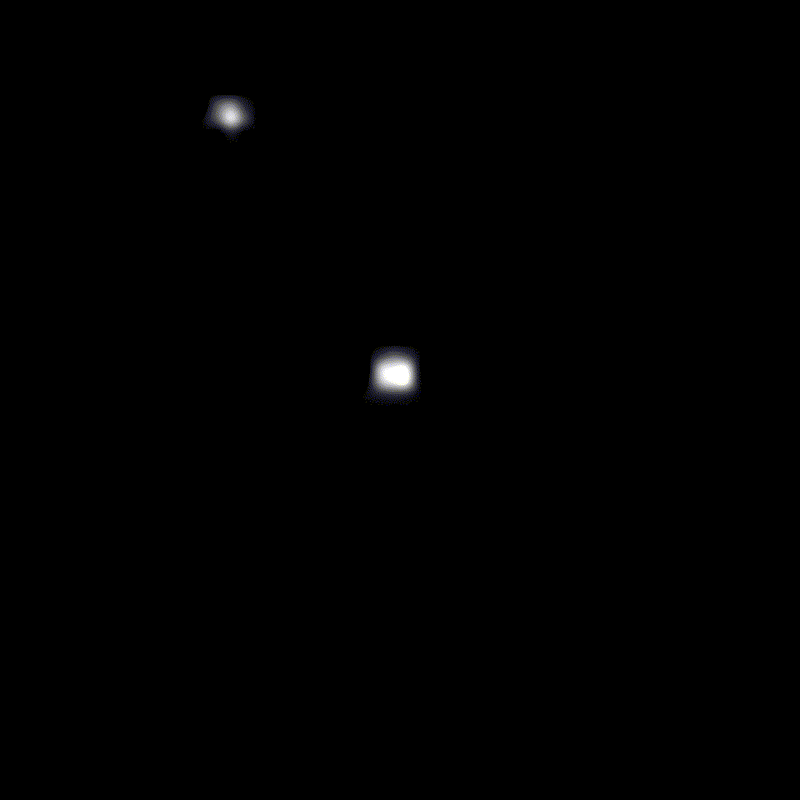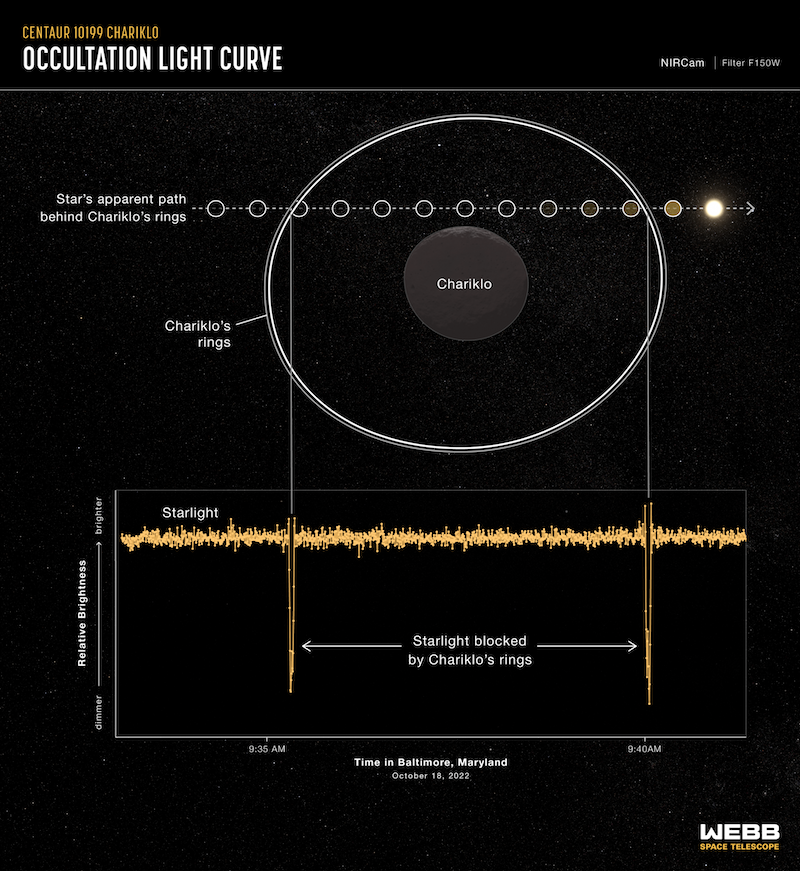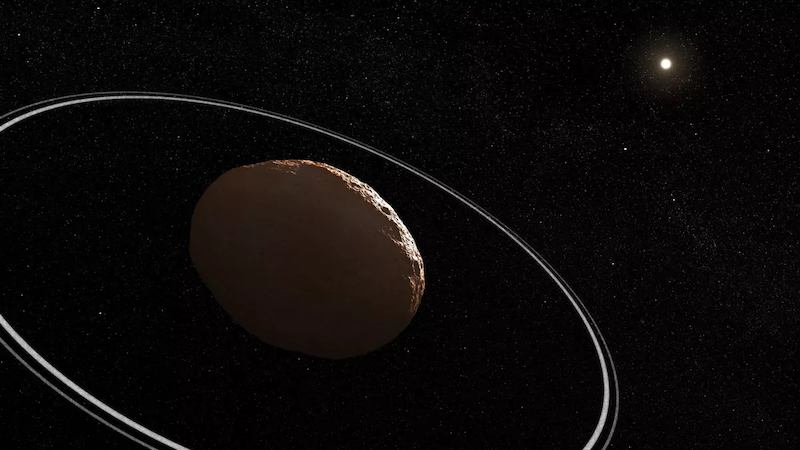
On January 25, 2023, NASA said in a blog post that the Webb space telescope has achieved another milestone. It observed the thin rings of Chariklo – the first asteroid known to have rings – a small icy body more than 2 billion miles (3 billion km) from Earth. That’s out past Saturn.
Webb did this by looking at Chariklo during a stellar occultation, where it passed in front of a distant star from Earth’s point of view. Webb saw the star blink not only as it passed behind the asteroid, but also as it passed behind Chariklo’s rings.
Chariklo is the largest known of the Centaur asteroids, which orbit the sun between Saturn and Uranus.
It should be noted that the results discussed here are part of Webb’s “science in progress” and haven’t yet been peer-reviewed. But they do provide a new, tantalizing glimpse of a ring system that some scientists previously doubted even could exist.
Webb observes Chariklo’s rings
The researchers wanted to attempt to see stellar occultations of Chariklo with Webb. This would be done, specifically, as part of the “Target of Opportunity” program (GTO 1271). Webb’s Guaranteed Time Observations (GTO) for the solar system includes this program. Pablo Santos-Sanz, from Instituto de Astrofísica de Andalucía in Granada, Spain, is the Principal Investigator for Target of Opportunity. Heidi Hammel from the Association of Universities for Research in Astronomy leads GTO.
So, would there be an ideal stellar occultation event during which to observe Chariklo? As it turned out there was, in October 2022. Moreover, this was not only the first stellar occultation for Chariklo, but also Webb’s very first stellar occultation of any kind. As the blog post explained:
On October 18, we used Webb’s Near-Infrared Camera (NIRCam) instrument to closely monitor the star Gaia DR3 6873519665992128512, and watch for the tell-tale dips in brightness indicating an occultation had taken place. The shadows produced by Chariklo’s rings were clearly detected, demonstrating a new way of using Webb to explore solar system objects. The star shadow due to Chariklo itself tracked just out of Webb’s view. This appulse (the technical name for a close pass with no occultation) was exactly as had been predicted after the last Webb course trajectory maneuver.
Successful occultation
To be sure, the occultation attempt was a great success. The blog post added:
The Webb occultation light curve, a graph of an object’s brightness over time, revealed that the observations were successful! The rings were captured exactly as predicted. The occultation light curves will yield interesting new science for Chariklo’s rings.
Even Webb can’t image the rings as distinct features from Chariklo itself, however. Generally speaking, Chariklo is simply too small and too far away. So in this case, a stellar occultation is the next best way to study them.

Composition of the rings
Astronomer Felipe Braga-Ribas and his colleagues first discovered the rings in 2013, using ground-based telescopes. Just like with Webb, they observed Chariklo pass in front of, or occult, a background star. But then, the astronomers noticed something interesting. The star blinked twice, both just before Chariklo moved in front of it and just after. Consequently, the astronomers realized that two thin rings around Chariklo caused the blinking. Indeed, this was the first time that astronomers had found such rings around a small asteroid-type body in the solar system.
Scientists estimate the rings to be between two and four miles (three and four km) wide.
That such a small body, only about 160 miles (250 km) in diameter, can have a ring system is fascinating. But also, what are the rings made of? Scientists say they are likely dark material mixed with ice particles. They believe the dark material is leftover debris from an ancient collision between Chariklo and another icy body.
In addition, water ice in the rings was a key discovery. Webb found it by looking at Chariklo again after the occultation. The telescope detected three distinct absorption bands of water ice. Noemí Pinilla-Alonso, who led the observations, said:
Spectra from ground-based telescopes had hinted at this ice (Duffard et al. 2014), but the exquisite quality of the Webb spectrum revealed the clear signature of crystalline ice for the first time.

New insights into Chariklo’s rings
Dean Hines, principal investigator of the GTO program, added:
Because high-energy particles transform ice from crystalline into amorphous states, detection of crystalline ice indicates that the Chariklo system experiences continuous micro-collisions that either expose pristine material or trigger crystallization processes.
Santos-Sanz added:
As we delve deeper into the data, we will explore whether we cleanly resolve the two rings. From the shapes of rings’ occultation light curves, we also will explore the rings’ thickness, the sizes and colors of the ring particles, and more. We hope to gain insight into why this small body even has rings at all, and perhaps detect new fainter rings.
It’s also possible that Chariklo may have a tiny moon or two as well. Scientists say they would help keep the rings narrow and confined, as we see them. Back in 2014, Braga-Ribas said:
So, as well as the rings, it’s likely that Chariklo has at least one small moon still waiting to be discovered.
Bottom line: NASA’s Webb telescope took its first look at tiny asteroid Chariklo’s rings, showing they contain water ice. Webb used a stellar occultation to observe the rings.
The post Webb observes Chariklo’s rings during occultation first appeared on EarthSky.
from EarthSky https://ift.tt/t9d6Tku

On January 25, 2023, NASA said in a blog post that the Webb space telescope has achieved another milestone. It observed the thin rings of Chariklo – the first asteroid known to have rings – a small icy body more than 2 billion miles (3 billion km) from Earth. That’s out past Saturn.
Webb did this by looking at Chariklo during a stellar occultation, where it passed in front of a distant star from Earth’s point of view. Webb saw the star blink not only as it passed behind the asteroid, but also as it passed behind Chariklo’s rings.
Chariklo is the largest known of the Centaur asteroids, which orbit the sun between Saturn and Uranus.
It should be noted that the results discussed here are part of Webb’s “science in progress” and haven’t yet been peer-reviewed. But they do provide a new, tantalizing glimpse of a ring system that some scientists previously doubted even could exist.
Webb observes Chariklo’s rings
The researchers wanted to attempt to see stellar occultations of Chariklo with Webb. This would be done, specifically, as part of the “Target of Opportunity” program (GTO 1271). Webb’s Guaranteed Time Observations (GTO) for the solar system includes this program. Pablo Santos-Sanz, from Instituto de Astrofísica de Andalucía in Granada, Spain, is the Principal Investigator for Target of Opportunity. Heidi Hammel from the Association of Universities for Research in Astronomy leads GTO.
So, would there be an ideal stellar occultation event during which to observe Chariklo? As it turned out there was, in October 2022. Moreover, this was not only the first stellar occultation for Chariklo, but also Webb’s very first stellar occultation of any kind. As the blog post explained:
On October 18, we used Webb’s Near-Infrared Camera (NIRCam) instrument to closely monitor the star Gaia DR3 6873519665992128512, and watch for the tell-tale dips in brightness indicating an occultation had taken place. The shadows produced by Chariklo’s rings were clearly detected, demonstrating a new way of using Webb to explore solar system objects. The star shadow due to Chariklo itself tracked just out of Webb’s view. This appulse (the technical name for a close pass with no occultation) was exactly as had been predicted after the last Webb course trajectory maneuver.
Successful occultation
To be sure, the occultation attempt was a great success. The blog post added:
The Webb occultation light curve, a graph of an object’s brightness over time, revealed that the observations were successful! The rings were captured exactly as predicted. The occultation light curves will yield interesting new science for Chariklo’s rings.
Even Webb can’t image the rings as distinct features from Chariklo itself, however. Generally speaking, Chariklo is simply too small and too far away. So in this case, a stellar occultation is the next best way to study them.

Composition of the rings
Astronomer Felipe Braga-Ribas and his colleagues first discovered the rings in 2013, using ground-based telescopes. Just like with Webb, they observed Chariklo pass in front of, or occult, a background star. But then, the astronomers noticed something interesting. The star blinked twice, both just before Chariklo moved in front of it and just after. Consequently, the astronomers realized that two thin rings around Chariklo caused the blinking. Indeed, this was the first time that astronomers had found such rings around a small asteroid-type body in the solar system.
Scientists estimate the rings to be between two and four miles (three and four km) wide.
That such a small body, only about 160 miles (250 km) in diameter, can have a ring system is fascinating. But also, what are the rings made of? Scientists say they are likely dark material mixed with ice particles. They believe the dark material is leftover debris from an ancient collision between Chariklo and another icy body.
In addition, water ice in the rings was a key discovery. Webb found it by looking at Chariklo again after the occultation. The telescope detected three distinct absorption bands of water ice. Noemí Pinilla-Alonso, who led the observations, said:
Spectra from ground-based telescopes had hinted at this ice (Duffard et al. 2014), but the exquisite quality of the Webb spectrum revealed the clear signature of crystalline ice for the first time.

New insights into Chariklo’s rings
Dean Hines, principal investigator of the GTO program, added:
Because high-energy particles transform ice from crystalline into amorphous states, detection of crystalline ice indicates that the Chariklo system experiences continuous micro-collisions that either expose pristine material or trigger crystallization processes.
Santos-Sanz added:
As we delve deeper into the data, we will explore whether we cleanly resolve the two rings. From the shapes of rings’ occultation light curves, we also will explore the rings’ thickness, the sizes and colors of the ring particles, and more. We hope to gain insight into why this small body even has rings at all, and perhaps detect new fainter rings.
It’s also possible that Chariklo may have a tiny moon or two as well. Scientists say they would help keep the rings narrow and confined, as we see them. Back in 2014, Braga-Ribas said:
So, as well as the rings, it’s likely that Chariklo has at least one small moon still waiting to be discovered.
Bottom line: NASA’s Webb telescope took its first look at tiny asteroid Chariklo’s rings, showing they contain water ice. Webb used a stellar occultation to observe the rings.
The post Webb observes Chariklo’s rings during occultation first appeared on EarthSky.
from EarthSky https://ift.tt/t9d6Tku

Aucun commentaire:
Enregistrer un commentaire